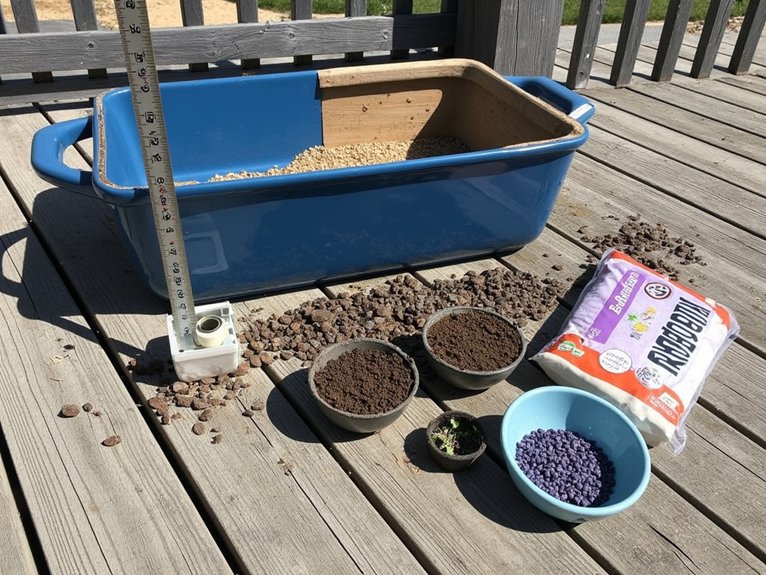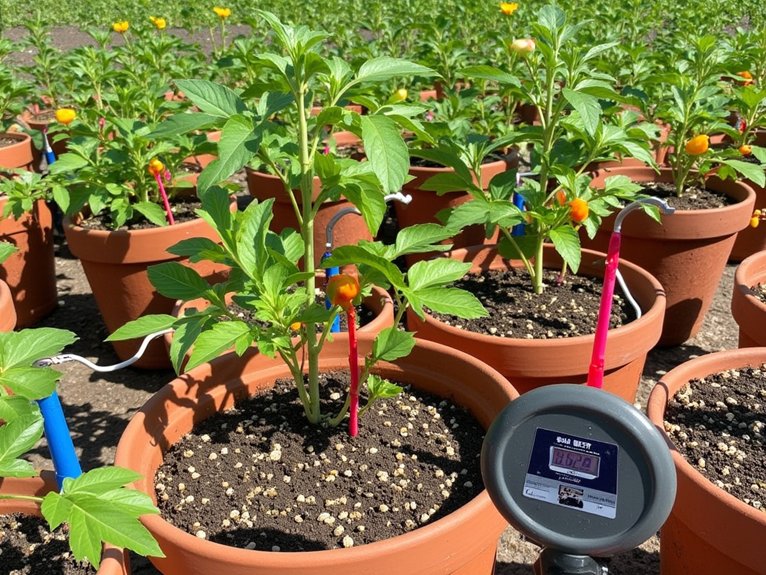You’ll find container pepper gardening uniquely rewarding once you master the essential techniques. As horticulturist Dr. Sarah Chen explains, “Success hinges on three critical factors: container selection, soil composition, and proper positioning.” Whether you’re growing sweet bells or fiery habaneros, your peppers need specific conditions to thrive in confined spaces. Understanding these fundamental requirements will transform your patio or balcony into a productive pepper paradise – and that’s just the beginning of what’s possible.
Contents
Essential Container and Soil Setup for Success

Whether you’re a novice gardener or seasoned pro, starting your pepper garden with the right container setup makes all the difference in achieving a bountiful harvest. Choose containers at least 12 inches in diameter and 10 inches deep, with proper drainage holes.
Different container materials offer unique benefits: terra cotta provides excellent airflow but needs frequent watering, while plastic retains moisture longer. When preparing your soil, mix quality potting soil with perlite and soil amendments like compost for ideal drainage and nutrients. Top with a layer of mulch, keeping it away from the plant’s stem to prevent rot.
Timing Your Pepper Garden for Maximum Growth
With your containers and soil ready to go, let’s focus on perfect timing for your pepper plants. Start most pepper varieties indoors 8-10 weeks before your region’s last frost date, maintaining temperatures between 70-80℉ for ideal growth.
When planting techniques matter most, wait until seedlings develop at least 2 true leaves before transplanting outdoors. If you’re in zones 9-11, you can direct sow in spring. Remember to place your containers where they’ll receive 6-8 hours of direct sunlight daily. For cooler climates, position pots near a south-facing wall for extra warmth, and provide afternoon shade when temperatures exceed 90℉.
Mastering Water and Nutrient Requirements

The art of watering container peppers requires careful attention to timing and technique. Your plants need 1-2 inches of water weekly, but you’ll want to check soil moisture daily since containers dry out faster than garden beds. When leaves start curling, it’s time to water deeply.
For ideal nutrient balance, mix a balanced organic fertilizer into your soil at planting time. Once your peppers start flowering, switch to a low-nitrogen formula every two weeks. Watch for signs of deficiency like yellowing leaves or stunted growth. Remember, consistent watering helps your plants absorb nutrients effectively.
Supporting and Protecting Your Pepper Plants
As your pepper plants grow taller and develop heavy fruits, they’ll need proper support to prevent stem damage and breakage. Install stakes or tomato cages when plants reach 12 inches tall, securing stems with soft fabric ties every 6-8 inches.
For effective pest management, inspect your plants weekly for signs of aphids, whiteflies, or cutworms. You’ll spot aphids as tiny clusters on leaves, while whiteflies appear as small white insects underneath. Remove any affected leaves and consider using organic insecticidal soap for serious infestations.
Keep plant support structures firmly anchored in the container soil, and adjust ties as your peppers grow to prevent stem constriction.
When and How to Harvest Your Container Peppers

Knowing exactly when to harvest your container peppers makes all the difference in their flavor and texture. Look for these ripeness indicators: full size development, firm flesh, and proper coloring based on variety.
To harvest your peppers:
- Use clean, sharp scissors or pruning shears
- Cut the stem about 1/4 inch above the fruit
- Don’t pull or twist, which can damage the plant
- Pick peppers when they’re green for mild flavor
- Wait until they change color for sweeter, fully ripe taste
Remember: Regular harvesting encourages more fruit production, so don’t let peppers linger too long on the plant.
